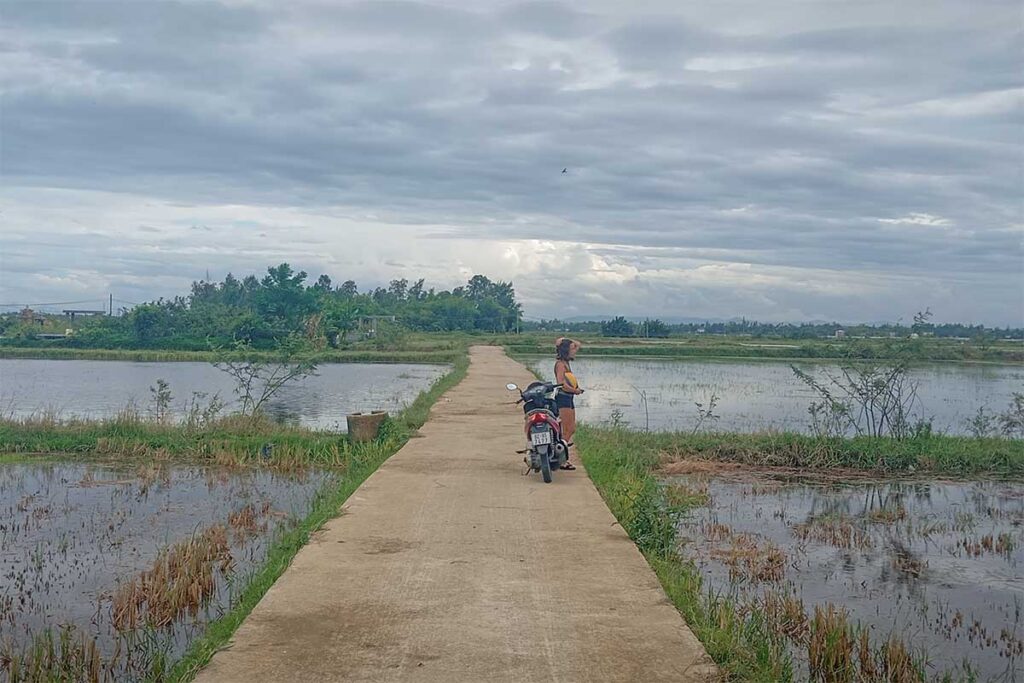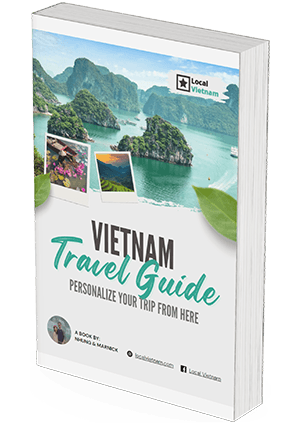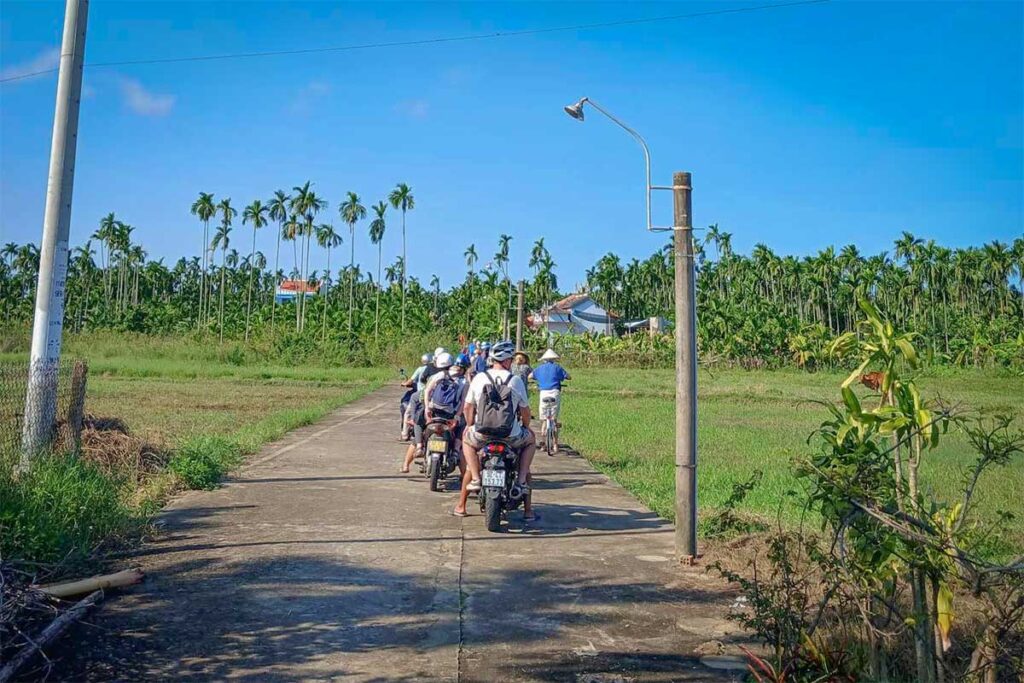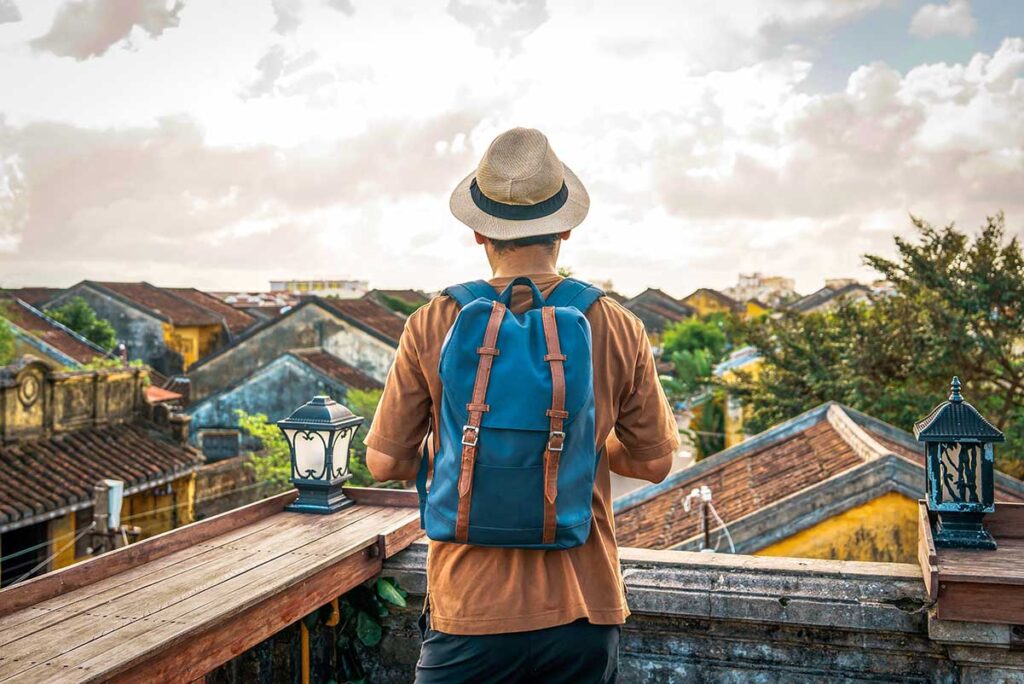What and where is Cam Kim Island?
Cam Kim Island is a rural river island located just south of Hoi An, easily reached by bridge or boat. It’s made up of several small villages like Kim Bong and Triem Tay, scattered among rice paddies, cornfields, and vegetable gardens. The island is known for its traditional crafts, quiet countryside, and lack of mass tourism — making it perfect if you’re looking for slow, authentic travel away from the crowds.
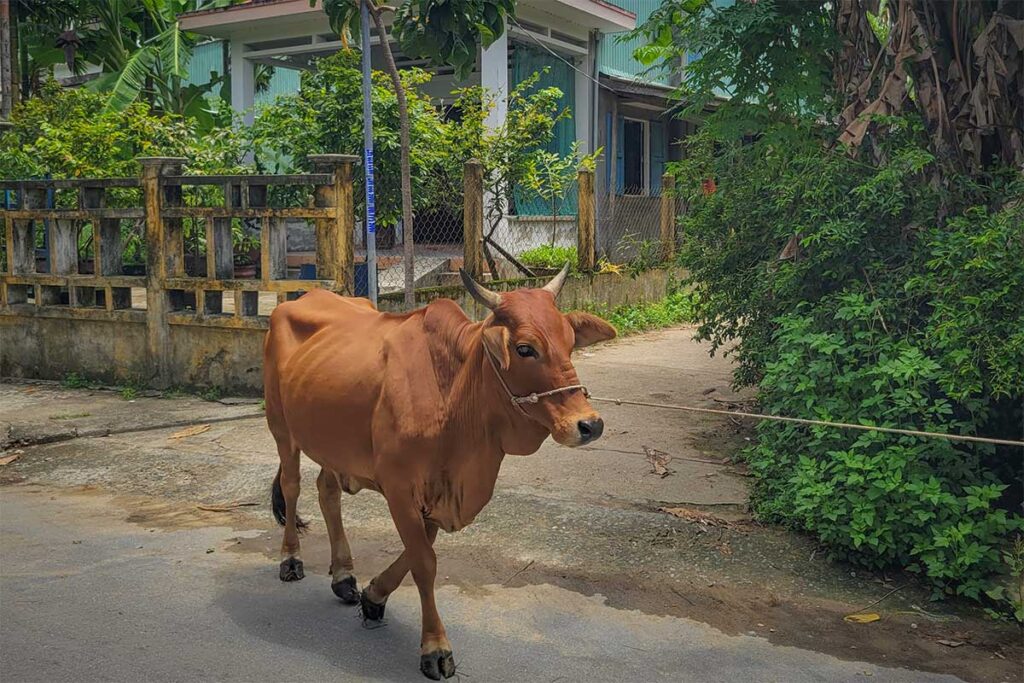
Best things to do on Cam Kim Island
If you’re looking for things to do on Cam Kim Island, expect a slower pace of travel. The island is all about peaceful cycling routes, hands-on crafts, and glimpses of real Vietnamese village life — without the tourist crowds of Hoi An.
1. Cycle through the countryside
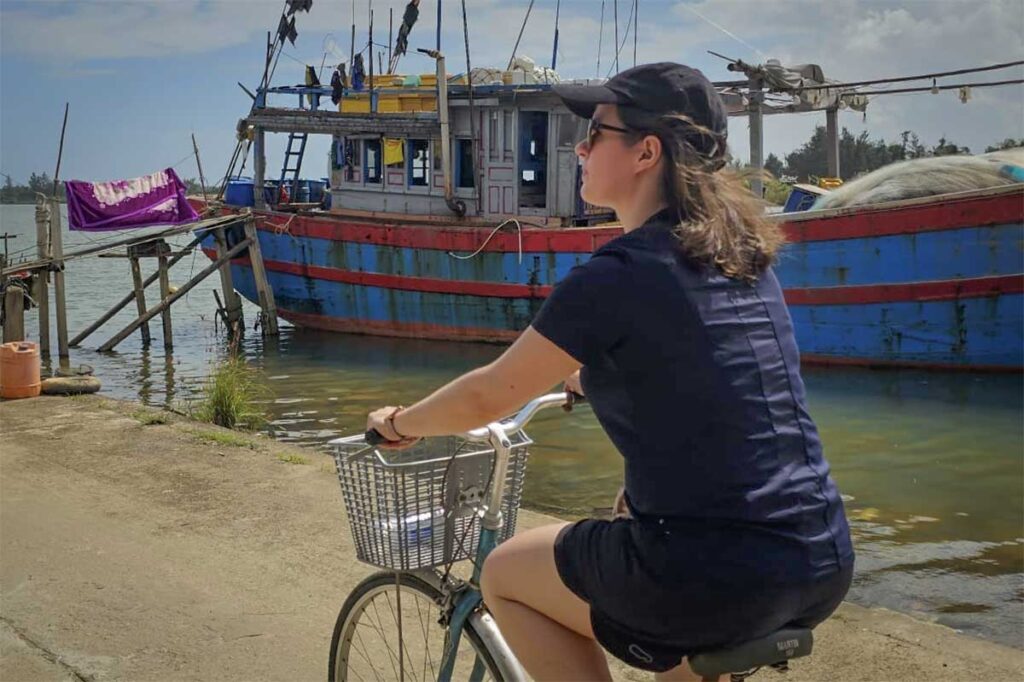
Cycling is the best way to explore Cam Kim. The roads are quiet and flat, winding past rice paddies, vegetable gardens, and riverbanks with fishing nets fluttering in the wind. You’ll pass through several small villages like Kim Bong and Triem Tay, with shaded lanes, cows grazing in fields, and the occasional temple or old house.

You can bring your own bike or rent one in Hoi An — most homestays and hotels in the Old Town offer them for free or you can rent them from tour shops for 50,000–100,000 VND per day. If you prefer a more in-depth experience, join a guided bicycle tour. Local guides not only help with navigation, but also arrange visits to workshops and homes that solo travelers might miss.
Read more about cycling around Hoi An.
2. Visit Kim Bong Carpentry Village
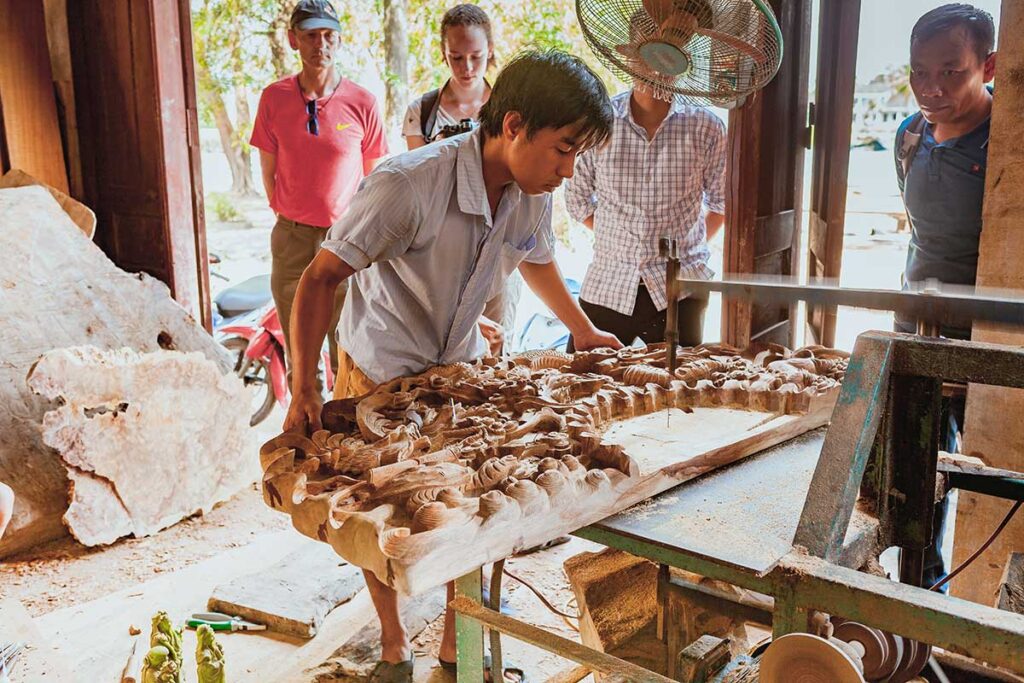
Kim Bong is the most famous village on the island and has a long history of traditional woodworking. Its artisans were responsible for building many of Hoi An’s old houses, temples, and boats — including elements of the Japanese Bridge. Today, the craft continues in small family-run workshops scattered along the riverside.
You can stop by to see shipbuilders shaping wooden hulls or carvers crafting intricate altars, statues, and souvenirs. Some places welcome you to try basic carving techniques or personalize a small item like a name plaque. It’s a good stop to learn about Hoi An’s building heritage and maybe pick up a handmade keepsake.
3. Explore a mat weaving workshop

In another part of the island, you’ll find small family homes where traditional sedge mats are woven by hand. The process uses dyed grass dried in the sun, then fed into hand-held looms. It’s repetitive but skilled work, and the mats are still widely used in Vietnamese homes.
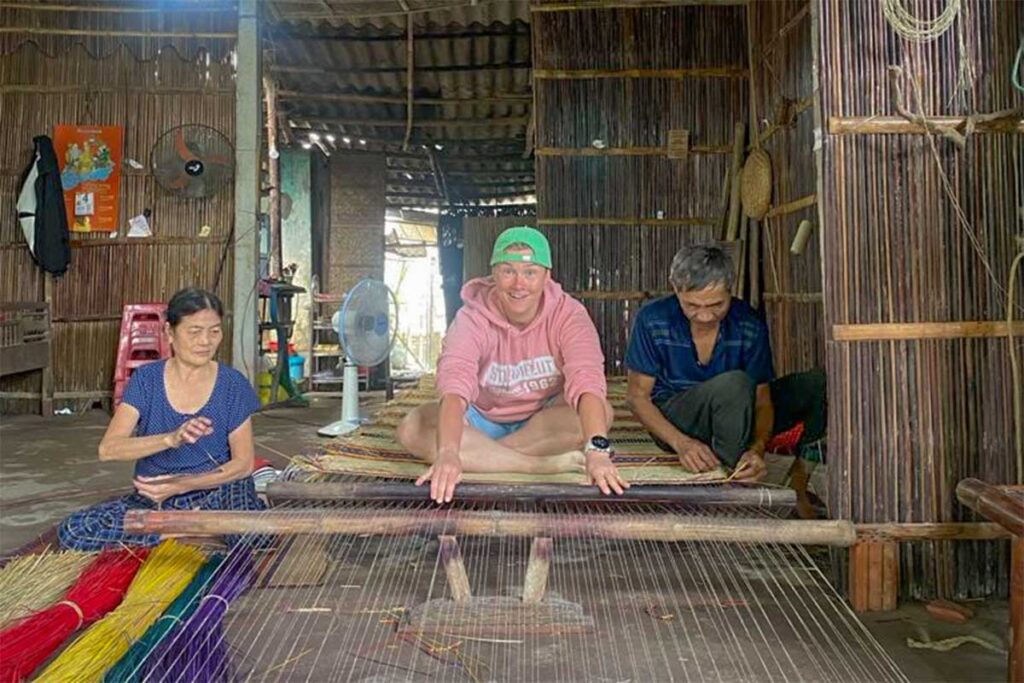
Locals are usually welcoming and happy to demonstrate if you stop by. While it’s not a commercial tourist setup, that’s part of the charm — you’re simply stepping into someone’s daily life. If you’re lucky, they’ll offer you a turn at the loom or explain how the natural dyes work.
4. Try rice paper and noodle making
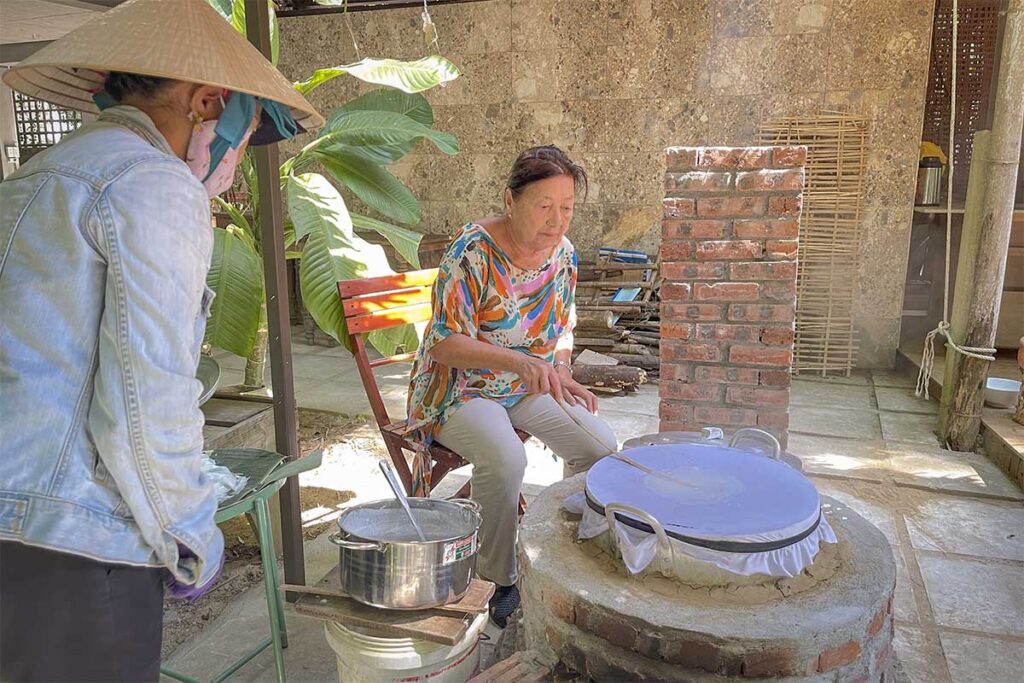
Scattered across Cam Kim are family-run setups where rice paper and noodles are still made the traditional way. Rice flour is spread thin on fabric steamers, dried on bamboo mats under the sun, and then cut into noodles or left as full sheets for local dishes.
These aren’t tourist attractions — they’re working homes — but if you’re respectful and curious, some families will happily explain or show the process. A few may even invite you to try it yourself. It’s a simple but rewarding way to see a part of daily life that hasn’t changed much in generations.
5. Visit Tra Nhieu Fishing Village & Coconut Forest
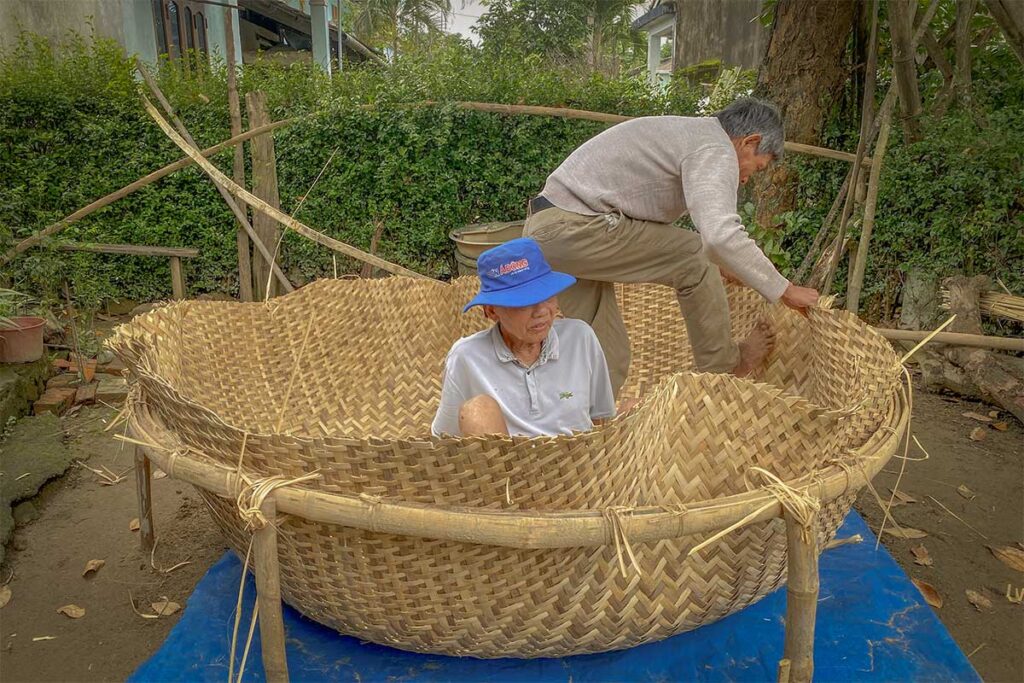
On the quieter eastern side of the island lies Tra Nhieu, a tranquil village where farming and fishing are still central. You’ll see vegetable gardens, shrimp ponds, and boats tied along the banks of the Thu Bon River. The area is also home to a water coconut forest, similar to the one in Cam Thanh but without the noisy crowds.
Basket boat rides and crab fishing are possible here — typically arranged through a local guide or host. It’s less about spectacle and more about observing and participating in rural life at a calm pace.
6. Explore Cam Kim Market
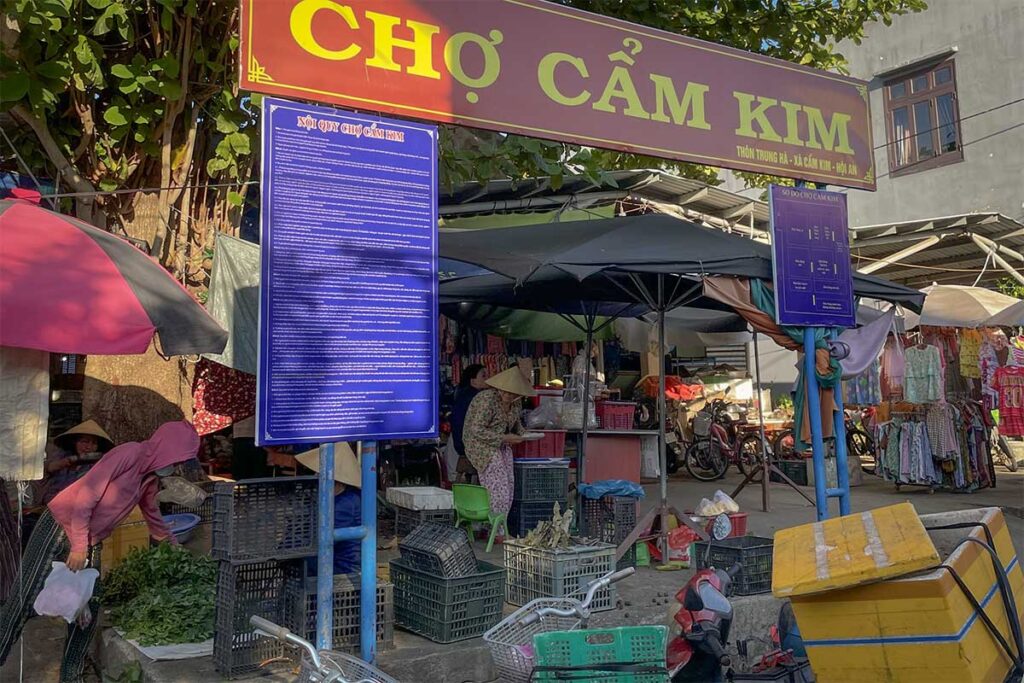

Cam Kim Market is a small, very local wet market near the center of the island. It’s best visited in the early morning, when it’s busiest and the produce is freshest. You’ll find vegetables from nearby fields, just-caught fish and shrimp, and a few interesting snacks like pandan jelly and mung bean milk.
It’s not big or designed for tourists, but that’s exactly what makes it worth a quick stop — it gives you a peek into everyday life on the island.
7. Take a boat tide over the Thu Bon River

One of the nicest ways to arrive on or leave Cam Kim is by boat. Traditional ferries run between the pier near Hoi An Central Market and Kim Bong Village, and you can usually bring your bicycle along. It’s a short but scenic trip, especially in the late afternoon when the river glows with sunset colors.
Some travelers choose to cycle to Cam Kim over the bridge, then return by boat — a relaxed way to end your visit with a change of scenery.
Read more about Thu Bon River boat tours.
8. Explore Triem Tay Village
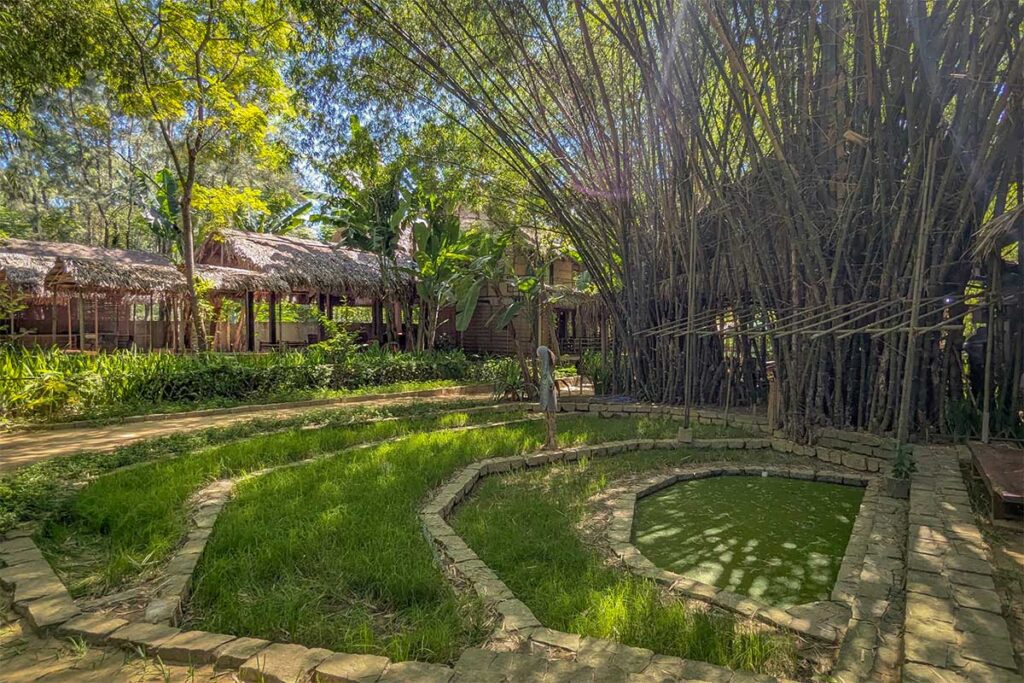
Triem Tay is one of the quieter corners of Cam Kim Island — a small riverside village with old houses, lush gardens, and shaded lanes. It’s a peaceful detour if you’re cycling the island and want to see a more hidden part of rural life.
The village has some restored heritage homes and a community garden project that reflects Hoi An’s efforts to preserve countryside culture. While not a major attraction, it adds a deeper layer to your ride — and chances are, you’ll have the place to yourself.
9. Watch traditional boat building

Near Kim Bong Carpentry Village, along the riverbanks, you’ll often see wooden boats in various stages of construction. This is one of the last places around Hoi An where traditional boat-building is still done by hand.

Skilled craftsmen shape fishing boats, tourist sampans, and cargo vessels using time-honored techniques. It’s not a show or a staged workshop — just local work in action — but a fascinating sight if you’re interested in craftsmanship and local trades.
10. Sample local food and drinks
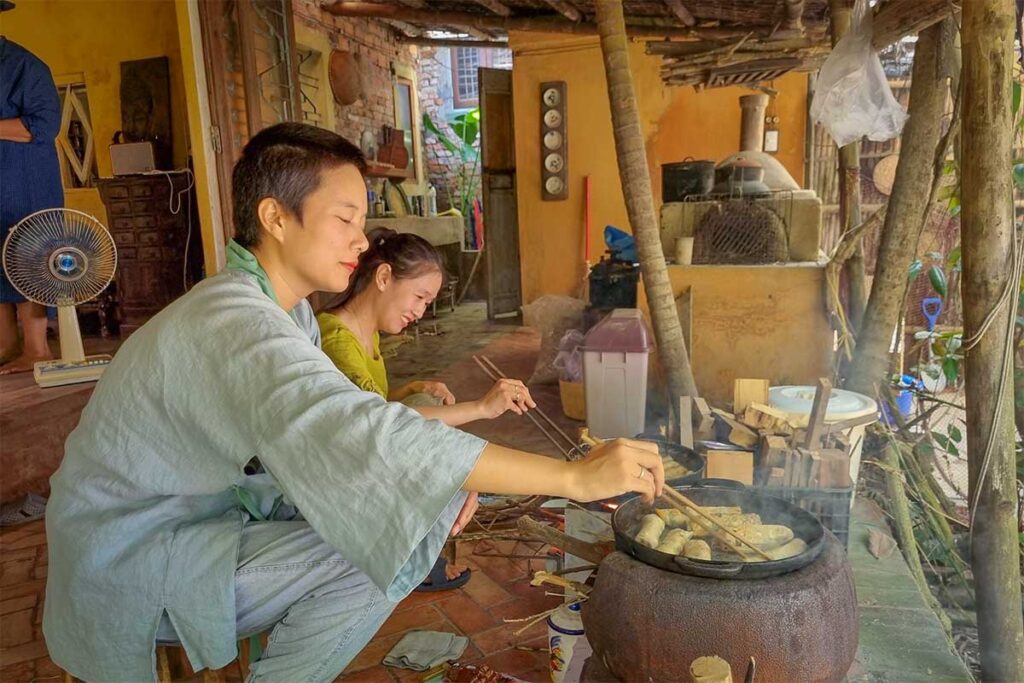
There aren’t many restaurants on Cam Kim, but you’ll find small eateries and family kitchens serving simple, fresh meals — often with ingredients straight from nearby fields or rivers. Dishes are basic but tasty: grilled fish, stir-fried vegetables, rice noodles.
For a break while cycling, stop for a glass of fresh sugarcane juice or a cold beer at one of the roadside stalls. These casual spots are part of the charm — no menu, no frills, just local life at its most relaxed.
Staying on Cam Kim Island
There are a handful of homestays and small hotels scattered around Cam Kim, mostly concentrated near Kim Bong Village. Facilities are basic — don’t expect many mid-range comforts, and definitely not large luxury resorts.

The island is quiet day and night, which makes it great for travelers who want a break from tourist crowds. You’ll wake up to sounds of roosters, bicycles, and river breezes — not karaoke bars or busy streets.
Dining options are very limited. Most visitors eat at their homestay, or cycle or ride into Hoi An Ancient Town for dinner. There are a few simple eateries in the villages, but no tourist-oriented restaurants.
Staying here is cheap and gives you a rare chance to experience daily rural life — but only if you’re okay with slow pace and simplicity. Great for peace seekers, not ideal for those looking for variety or nightlife.
How to get to Cam Kim Island
Cam Kim is just across the Thu Bon River from Hoi An and easy to reach — but it depends on how you want to travel.
By bridge
There are two bridges called Cam Kim Bridge, which can be confusing.
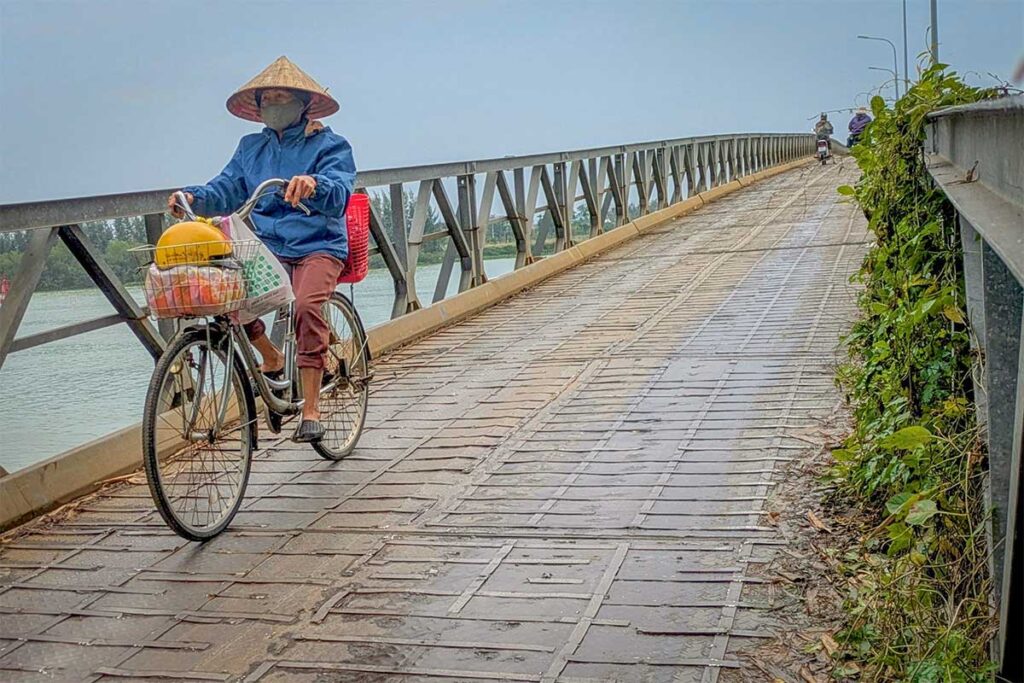
The closest one to the Old Town is a narrow steel bridge at the end of Nguyen Phuc Tan Street. It’s only for motorbikes, bicycles, and pedestrians — no cars. Crossing it is part of the charm, especially if you’re cycling.
The second bridge is further west and suitable for cars. It connects to Thanh Ha and lets you drive directly onto the island.
These two bridges are the only land connections between Cam Kim and the popular northern areas of Hoi An like the Ancient Town, An Bang Beach, and Cua Dai.
By boat
You can also take a traditional ferry or small boat from the dock near Bach Dang Street (next to Hoi An Central Market). It’s a scenic ride and drops you near Kim Bong Village — ideal if you’re coming on foot or with a rented bike.

By bicycle or biking tour
Cycling is the best way to explore Cam Kim Island. You can rent a bike in Hoi An, use a free one from your accommodation, or join a guided tour for deeper access and context.
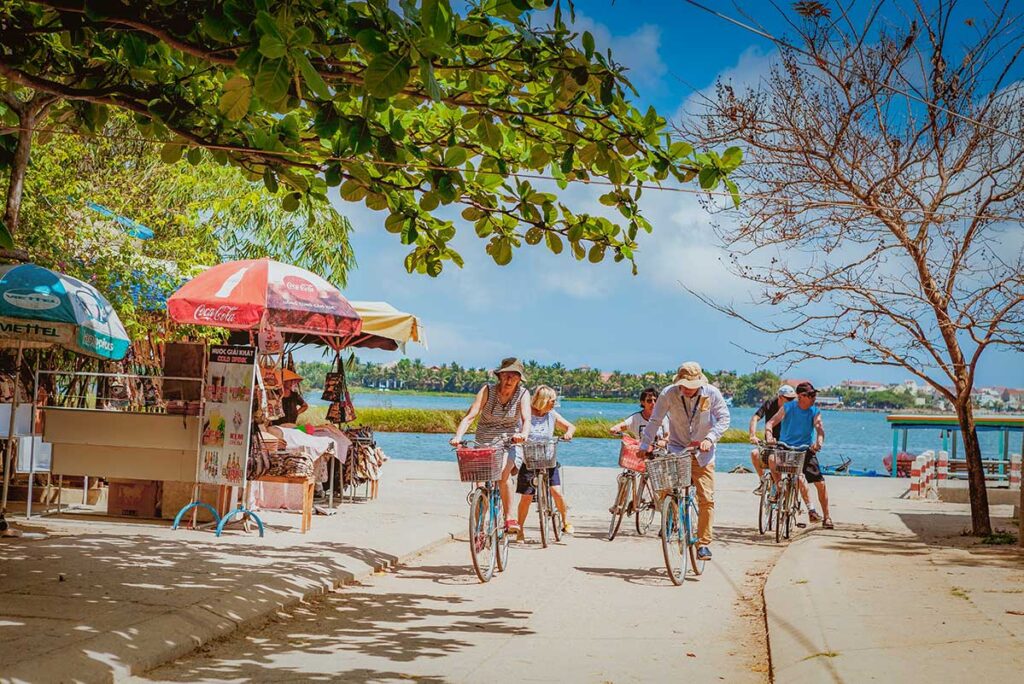
That said, most people only bike around the Ancient Town area. Cam Kim is less visited, so if you want to explore beyond the usual path — including workshops and small villages — a guided biking tour is highly recommended.
Tips for visiting Cam Kim Island
- Go in the morning when it’s cooler. Much of the island is open countryside with little shade, so it can get hot by midday.
- Best season to visit is from March to August, during the dry months. Expect sunshine, clear skies, and easy cycling conditions.
- What to bring: Water, a hat, sunscreen, and an internet SIM if you’re exploring solo — signage is limited and Google Maps can be useful.
- Be respectful. This is still a very local, non-touristy area. People are friendly, but daily life comes first.
- Consider a local guide if you want more than just a bike ride — a guide can introduce you to craftspeople, explain cultural details, and help with language barriers.
- If taking a boat, return before dark. There’s no fixed ferry schedule, and the last ride back to Hoi An can vary depending on weather and demand.
Is Cam Kim Island worth a visit?
Yes — if you enjoy cycling, quiet countryside, and off-the-beaten-path experiences. It’s best explored as a half-day or full-day trip from Hoi An, combining a scenic bike ride, a boat trip across the Thu Bon River, and visits to traditional craft villages like Kim Bong.
For staying overnight, the options are limited and quite basic. While Hoi An Ancient Town is still nearby by bike, getting there by taxi is less convenient — the closest bridge is narrow and only for motorbikes and bicycles, so cars need to take a longer detour.
If you’re looking for a peaceful local experience and don’t need restaurants, shops, or nightlife, Cam Kim is a great contrast to the tourist crowds in town.
